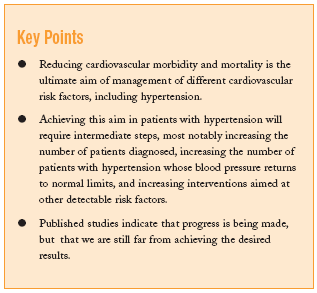Hypertension (HT), because of its high prevalence and repercussions on cardiovascular morbidity and mortality, is one of the most frequent problems encountered by family physicians in daily clinical practice, and represents one of the greatest challenges faced by these professionals. The data now available regarding the frequency and repercussions of HT are ample and solid, but so is the evidence for the benefits of appropriate intervention. These benefits depend to a great extent (albeit with some caveats) more on the effect achieved (reduction in blood pressure) than on the method used to achieve it.
The ultimate aim of management of patients with HT, as noted in the various international consensus documents currently in use, is to reduce cardiovascular and renal morbidity and mortality. But attaining these end results means first achieving intermediate goals, which can be evaluated from an individual viewpoint or in population-based terms. If an individual focus is used, the main objectives for patients with HT are to reduce blood pressure figures (currently accepted figures for the general population are <140 mm Hg for systolic pressure and <90 mm Hg for diastolic pressure), and to reduce overall cardiovascular risk. These aims require integrated actions aimed at different risk factors. From a population-based viewpoint, the main objectives for HT are two: to identify as many patients with HT as possible (i.e., to bring the known prevalence into synch with the theoretical prevalence, according to several studies, of around 25% to 40% in the adult population), and to lower blood pressure values to below the figures given above in as many of these patients as possible.
The article on the DISEHTAC II study in this issue of Atención Primaria tells us how close we are to achieving some of these intermediate objectives by reporting the percentage of patients with HT whose blood pressure is within the appropriate range, and by providing information on the other cardiovascular risk factors in these patients.
The changes in the percentage of patients with HT whose blood pressure values are below the highest acceptable limit are worth some comment. Considering both national criteria (i.e., cutoff values proposed by the Controlpress study) and international criteria (for example, the cutoff values used in the National Health and Nutrition Examination Survey), the trend is favorable, with increasing percentages of patients showing good control. This trend was also seen in the DISEHTAC II study (32.4% vs 25.7% in the DISEHTAC I study in 1996). However, the trees should not prevent us from seeing the forest: although a favorable trend was apparent, only 1 of every 3 patients diagnosed as having HT had acceptable blood pressure values. Change is real but slow, so we need to think about what we could do to accelerate progress. For example, can we improve compliance with therapy? Are we doing enough to modify lifestyles? Should we use more aggressive pharmacological interventions?
Another important aspect that the DISEHTAC II study examines is the identification and management of associated cardiovascular risk factors. As noted, the ultimate aim is to reduce cardiovascular risk, but this will be hard to achieve if we do not continually evaluate risk factors and act in a coordinated manner to influence them. How each patient with HT is managed will depend on the detection of risk factors, the accurate calculation of cardiovascular risk, and the development of individualized, multifactorial interventions. In this regard the data supplied by the DISEHTAC II study are not only noteworthy, but in fact give cause for alarm: risk factors are being studied systematically in only 1 out of every 2 patients with HT, and cardiovascular risk is calculated in only 1 out of every 10 patients. Moreover, little progress has been made since the DISEHTAC I survey. Could this be due to underreporting, as the authors suggest? Are we neglecting to use integrated approaches in the management of these patients? If so, why? The answers to these questions may help us remedy these shortcomings.
The data from the DISEHTAC II study corroborate what other research has found: we are making progress in managing patients with HT, but the situation is still far from optimal. The data should not lull us into complacency, but in contrast, should spur us to seek continued improvements.









